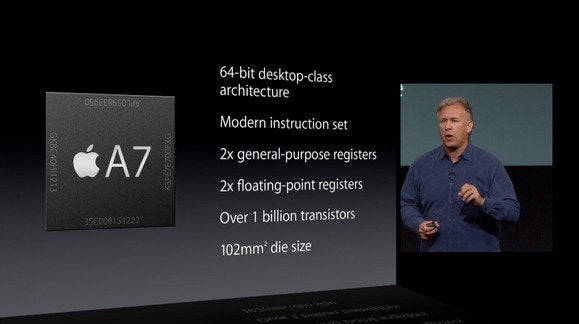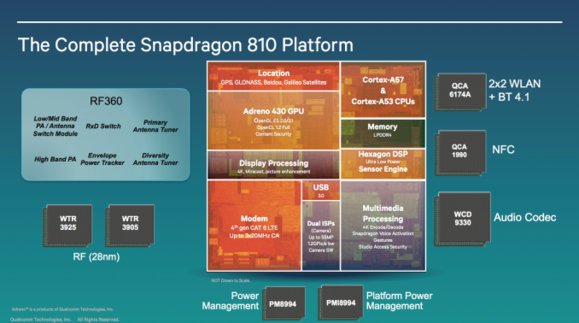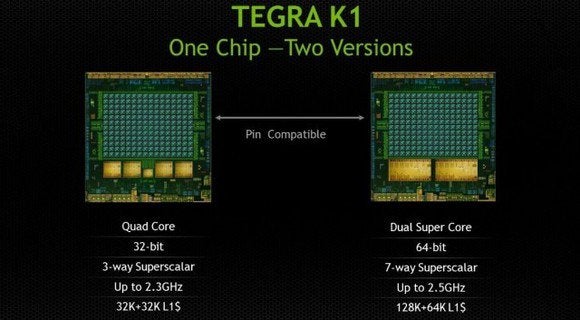
앞으로 몇 달 동안 64 비트 프로세서를 트럼펫으로 사용하는 많은 새로운 휴대폰을 보게 될 것입니다. Should you run out to get one? 당신은 하나를 얻기 위해 밖으로 실행해야합니까? Is 64-bit silicon twice as good as that crummy 32-bit technology we've been using for years? 64 비트 실리콘은 오랫동안 사용해온 32 비트 기술보다 두 배나 우수할까요? The short answer is no. 짧은 대답은 '아니오'입니다. The longer answer is that the move to a newer ARM architecture includes some nice enhancements, but being 64-bit isn't, by itself, all that important. 더 긴 대답은 최신 ARM 아키텍처로의 이전에는 약간의 향상된 기능이 포함되어 있지만 64 비트는 그 자체로 모든 것이 중요하지 않다는 것입니다.
Before you pull out your wallet to snag the first 64-bit Android phone (the HTC Desire 510), or begin salivating over any of the other 64-bit phones coming this fall, let's discuss what the term 64-bit really means, and why you should, and shouldn't , care about it. 올 가을에 처음으로 64 비트 안드로이드 폰 (HTC Desire 510)에 걸려 지갑을 꺼내거나 다른 올인원 64 비트 폰에 침투하기 전에 64 비트라는 용어가 실제로 무엇을 의미하는지 토론 해 봅시다. 왜 그렇게해야하고, 그렇게 해서는 안됩니다 .
Just what is a 64-bit processor, anyway?어쨌든 64 비트 프로세서 란 무엇입니까?
Ask around, and you'll hear numerous definitions of the term “64-bit processor.” Most often, you'll hear that it means the processor can use more than 4GB of RAM. 주변에서 물어 보면 "64 비트 프로세서"라는 용어에 대한 수많은 정의가 나옵니다. 대부분의 경우 프로세서가 4GB 이상의 RAM을 사용할 수 있다는 것을 알게됩니다. This isn't really true, as a chip's “bit count” doesn't really have anything to do with how much memory it can address. 칩의 "비트 수"가 실제로 처리 할 수있는 메모리의 양과 관련이 없기 때문에 이것은 사실이 아닙니다.
Processors use two kinds of numbers to perform operations like addition, multiplication, and moving or copying data in memory. 프로세서는 두 종류의 숫자를 사용하여 메모리에서 더하기, 곱하기 및 이동 또는 복사 작업을 수행합니다. You have your integers (whole numbers like 90210) and floating-point numbers (those with decimals like 3.14159265359). 정수 (90210과 같은 정수)와 부동 소수점 수 (3.14159265359와 같은 십진수가있는 정수)가 있습니다. If a processor can handle integer operations up to 16 bits long, it's a 16-bit processor. 프로세서가 최대 16 비트 길이의 정수 연산을 처리 할 수있는 경우 프로세서는 16 비트 프로세서입니다. If it can handle a 32-bit integer operation, it's 32-bit, and (you guessed it) a 64-bit processor can handle 64-bit integers. 32 비트 정수 연산을 처리 할 수 있다면 32 비트이므로 64 비트 프로세서가 64 비트 정수를 처리 할 수 있습니다 (추측).

Apple introduced the first 64-bit, ARMv8 phone processor last year with the A7. 애플은 작년에 A7과 함께 최초의 64 비트 ARMv8 폰 프로세서를 발표했다.
A 32-bit processor also uses 32 bits to point to locations in memory, while a 64-bit processor uses 64 bits. 또한 32 비트 프로세서는 32 비트를 사용하여 메모리의 위치를 가리키고 64 비트 프로세서는 64 비트를 사용합니다. That means that a single program can address only 4GB with a 32-bit chip, even if the processor itself can address more. 즉, 프로세서 자체가 더 많은 것을 처리 할 수 있다고해도 단일 프로그램 이 32 비트 칩으로 4GB 만 처리 할 수 있습니다. A 64-bit processor points to memory locations using 64 bits, allowing individual programs to address 16 exabytes —a practically unlimited amount of memory. 64 비트 프로세서는 64 비트를 사용하여 메모리 위치를 가리키며, 개별 프로그램이 16 엑사 바이트 ( 실제로는 무제한 메모리)를 처리 할 수 있습니다.
For most apps, a 64-bit processor doesn't offer much benefit. 대부분의 앱에서 64 비트 프로세서는 많은 이점을 제공하지 않습니다. Most of the apps we use on our phones and tablets really don't have much need for 64-bit integer operations, or more than 4GB of memory per program. 휴대 전화와 태블릿에서 사용하는 대부분의 앱에는 64 비트 정수 연산이 필요하지 않으며 프로그램 당 4GB 이상의 메모리가 필요하지 않습니다. In fact, a 64-bit app can sometimes run slower than a 32-bit app, because using all those 64-bit memory pointers can make the app larger, sucking up more cache and RAM. 실제로 64 비트 응용 프로그램은 32 비트 응용 프로그램보다 느리게 실행될 수 있습니다. 왜냐하면 64 비트 메모리 포인터를 모두 사용하면 응용 프로그램을 더 크게 만들 수있어 캐시와 RAM을 더 많이 차지할 수 있기 때문입니다.
So why are 64-bit mobile processors better?그렇다면 64 비트 모바일 프로세서는 왜 더 나은가요?
The move from 32-bit to 64-bit ARM processors in our Android devices is just one development in a greater, much more important change: the move from the ARMv7 architecture to ARMv8. Android 디바이스에서 32 비트에서 64 비트 ARM 프로세서로의 이전은 ARMv7 아키텍처에서 ARMv8 로의 이전과 같이 훨씬 더 중요한 변화에서 단 하나의 개발 일뿐입니다.
For nearly the past decade, all the chips in our smartphones have been based on one principle set of supported instructions and features—ARMv7. 지난 10 년 간 스마트 폰의 모든 칩은 지원되는 지침 및 기능 (ARMv7)의 한 가지 원칙 집합을 기반으로했습니다. All our modern smartphones, from the original iPhone and T-Mobile G1 through the iPhone 5 and Galaxy S5, have been built with processors that adhere to the ARMv7 specifications. 원래 iPhone 및 T-Mobile G1에서부터 iPhone 5 및 Galaxy S5에 이르기까지 모든 최신 스마트 폰은 ARMv7 사양을 준수하는 프로세서로 제작되었습니다. Yes, ARMv7 has had its share of improvements and extensions over the years, but at its core, it's still the same fundamental architecture we've been stuck with for almost a decade. 예, ARMv7은 지난 몇 년 동안 개선과 확장이 있었지만, 핵심적으로 우리가 거의 10 년 동안 함께해온 기본 아키텍처와 여전히 동일합니다.
And ARMv7 is getting a little long in the tooth. 그리고 ARMv7은 약간 길어지고 있습니다. So about three years ago, ARM introduced a new standard all the chip makers can build processors around—ARMv8. 따라서 약 3 년 전에 ARM은 ARMv8을 중심으로 프로세서를 제작할 수있는 새로운 표준을 도입했습니다.
ARMv8 includes a whole host of improvements. ARMv8은 향상된 기능을 제공합니다. It takes all the ARMv7 instructions that today's processors must handle by default, and streamlines them. 현재 프로세서가 기본적으로 처리해야하는 모든 ARMv7 명령어가 필요하며이를 간소화합니다. New instructions for modern applications have been added, and old, depreciated instructions have been thrown out. 현대적인 응용 프로그램에 대한 새로운 지침이 추가되었으며 오래된 감가 상한 지침이 삭제되었습니다. Special instructions applicable to encryption have been added, too. 암호화에 적용 할 수있는 특별 지침이 추가되었습니다. What's more, the spaces inside a processor where commonly used instructions and data are stored—they're called registers—have roughly doubled in number in ARMv8. 게다가 일반적으로 사용되는 명령어와 데이터가 저장되는 프로세서 내부 공간 (레지스터라고 함)은 ARMv8에서 약 두 배가되었습니다. That's a big deal, because it means an ARMv8 processor will spend less time pulling data from memory. 이는 ARMv8 프로세서가 메모리에서 데이터를 가져 오는 데 소요되는 시간을 줄이기 때문에 큰 의미가 있습니다.

Qualcomm's first 64-bit chips are low- and mid-range. Qualcomm 최초의 64 비트 칩은 저전력 및 중급입니다. But high-end chips like the 810 are coming soon. 그러나 810과 같은 고급 칩은 곧 출시 될 예정입니다.
And, of course, ARMv8 is 64-bit capable, all while maintaining compatibility with older 32-bit ARM software. 물론 ARMv8은 64 비트 가능하며 이전 버전의 32 비트 ARM 소프트웨어와의 호환성을 유지합니다.
When all is said and done, the new ARMv8 architecture is what makes 64-bit chips faster and more efficient, not merely the fact that they're 64-bit. 모든 것이 끝나고 나면 새로운 ARMv8 아키텍처는 64 비트 칩을 더 빠르고 효율적으로 만드는 기능입니다. You don't get one without the other, but it's a lot easier to celebrate “64-bit” in a press release than try to explain the benefits of increased register space or a refined instruction set. 다른 하나 없이는 하나도 얻지 못하지만, 레지스터 공간이 넓어 지거나 세련된 명령어 세트의 이점을 설명하기보다는 보도 자료에서 "64 비트"를 축하하는 것이 훨씬 쉽습니다.
Is 64-bit really going to make a big difference?64 비트는 실제로 큰 차이를 만들 것입니까?
Well, yes and no. 네, 그렇습니다. The first Android products to bear 64-bit chips will offer performance that's all over the map. 64 비트 칩을 탑재 한 최초의 안드로이드 제품은 모든 기능을 제공합니다. The HTC Desire 510, for example, is a budget phone powered by a Qualcomm Snapdragon 410 processor. 예를 들어, HTC Desire 510은 Qualcomm Snapdragon 410 프로세서를 탑재 한 예산 휴대 전화입니다. The Desire 510 is based on the ARMv8 architecture and is 64-bit, but it's still a low-end handset that's going to be slower than most of the high-performance phones already on the market. Desire 510은 ARMv8 아키텍처를 기반으로하며 64 비트이지만 아직 출시 된 고성능 휴대 전화보다 느린 로우 엔드 핸드셋입니다. Qualcomm's next 64-bit chips to hit the market will be the mid-range Snapdragon 610 and 615 chips—and they're still nothing to get worked up about. Qualcomm의 차세대 64 비트 칩은 Snapdragon 610 및 615 중급 칩이 될 것이며 아직까지는 성공할 수 없습니다. The pedal really hits the medal early next year, when we expect devices bearing the high-end Snapdragon 810 chips. 하이 엔드 Snapdragon 810 칩을 탑재 한 장치가 출시 될 것으로 예상되는 내년 초에 페달이 실제로 메달을 쳤습니다.
On the other hand, we may see tablets sporting the dual-core 64-bit version of Nvidia's Tegra K1 chip before the year is out, and that processor should be very fast, indeed. 다른 한편으로는 올해가 끝나기 전에 Nvidia의 Tegra K1 칩의 듀얼 코어 64 비트 버전을 사용하는 태블릿을 볼 수 있으며 그 프로세서는 실제로 매우 빨라야합니다.

Nvidia's Tegra K1 is on the market already, but a second version with a 64-bit CPU is coming soon. Nvidia의 Tegra K1은 이미 출시되었지만 64 비트 CPU를 갖춘 두 번째 버전이 곧 출시 될 예정입니다.
Consider this: Apple's iPhone 5S has a 64-bit mobile chip, and it has been on shelves for about a year. 이것을 고려해보십시오. Apple의 iPhone 5S에는 64 비트 모바일 칩이 있으며 약 1 년 동안 선반 위에 있습니다. It's very fast, but that hasn't stopped Android phones from matching its performance with lowly 32-bit processors. 매우 빠르지 만 안드로이드 폰의 성능이 낮은 32 비트 프로세서와 일치하지 않습니다. Moral of the story: Faster processors are always on the way, 64-bit or not. 이야기의 도덕 : 더 빠른 프로세서는 언제나 존재합니다 (64 비트인지 여부).
So, don't be hoodwinked by the inevitable “64-bit” checkbox on the specs sheet. 따라서 사양 시트의 필연적 인 "64 비트"체크 상자를 두드리지 마십시오. The move to ARMv8, 64-bit mobile processors is a very good thing, but not every 64-bit processor is faster than every 32-bit processor. ARMv8, 64 비트 모바일 프로세서로의 이전은 아주 좋은 일이지만 모든 64 비트 프로세서가 모든 32 비트 프로세서보다 빠르지는 않습니다.
64-bit really needs Android L to shine64 비트는 Android L이 빛나기 위해 정말로 필요합니다.
There's one more piece to this puzzle: the operating system. 이 퍼즐에는 운영 체제가 하나 더 있습니다. If you buy a 64-bit phone with Android 4.4 KitKat on it, you won't really unlock its potential until it gets an upgrade to Android L. Android 4.4 KitKat이 설치된 64 비트 전화기를 구입하면 Android L로 업그레이드 할 때까지 잠재력을 실제로 해제하지 않습니다.
You see, to properly utilize ARM's new 64-bit architecture, you'll need both operating system and application support. ARM의 새로운 64 비트 아키텍처를 제대로 활용하려면 운영 체제와 응용 프로그램을 모두 지원해야합니다. Android L has been designed to fully support ARMv8 and 64-bit platforms, while KitKat has not.안드로이드 L 은 ARMv8 및 64 비트 플랫폼을 완벽하게 지원하도록 설계되었으며 KitKat는 그렇지 않습니다. But what about apps? 하지만 앱은 어떨까요? Do you need to wait for app developers to create special 64-bit-optimized versions of their apps? 앱 개발자가 특별한 64 비트 최적화 버전의 앱을 만들 때까지 기다려야합니까?

Android L brings with it a ton of new features, among which is full support for ARMv8 and 64-bit. Android L은 다양한 기능을 제공하며 그 중 ARMv8 및 64 비트를 완벽하게 지원합니다.
Well, apps will get faster and more efficient when developers optimize for these new chips, but you may not have to wait to see benefits. 글쎄, 개발자가 새로운 칩을 최적화 할 때 앱은 더 빠르고 효율적이 될 것이지만 이점을보기 위해 기다릴 필요가 없을 수도 있습니다. On Android, most apps are based on Java. Android에서 대부분의 앱은 Java를 기반으로합니다. So when you download an Android app, you're really grabbing a package of zipped-up code and libraries that the Android OS turns into a functional program that can be understood by your phone's processor. 따라서 Android 앱을 다운로드하면 Android OS가 휴대 전화 프로세서에서 이해할 수있는 기능적 프로그램으로 바뀌는 압축 된 코드 및 라이브러리 패키지를 실제로 얻게됩니다. This is called “compiling.” 이를 "컴파일"이라고합니다.
The compiler in Android L, known as ART, is made to produce code that's optimized for the new ARM architecture. ART로 알려진 Android L의 컴파일러는 새로운 ARM 아키텍처에 최적화 된 코드를 생성합니다. So, with Android L and a 64-bit processor in your phone or tablet, your apps could run faster without a developer lifting a finger to make special optimizations. 따라서 휴대 전화 또는 태블릿에 Android L 및 64 비트 프로세서가 있으면 개발자가 손가락을 들어 특수 최적화를 수행하지 않아도 앱이 더 빨리 실행될 수 있습니다. And if they do make those optimizations, their apps could run even better. 개발자가 최적화 작업을 수행하면 앱을 더 효과적으로 운영 할 수 있습니다.
By this time next year, we'll have forgotten all about 64-bit내년 이맘때까지 우리는 64 비트에 대한 모든 것을 잊어 버릴 것입니다.
Marketing departments love the term 64-bit. 마케팅 부서는 용어 64 비트를 좋아 합니다. Any time they can put a number twice as big on the box, they're going to. 언제든지 상자에 두 배나 큰 숫자를 넣을 수 있습니다. You're using a 32-bit phone now, so if you're anything like the typical human, your emotional triggers will tell you a 64-bit phone is twice as fast. 현재 32 비트 전화기를 사용하고 있으므로 일반적인 사람과 같은 사람이라면 감정적 인 자극을 통해 64 비트 전화가 두 배 빠릅니다. It's why we see cameras crammed with more megapixels, and processors with more cores. 그래서 우리는 카메라가 더 많은 메가 픽셀과 더 많은 코어를 가진 프로세서로 가득 찬 이유를 보았습니다. More always equals better, right? 항상 더 나은 평등, 맞죠?
In this case, the marketing departments aren't wrong , they're just overstating the importance of 64-bit to the Android market. 이 경우 마케팅 부서는 잘못 되지 않았으며 Android 마켓에 64 비트의 중요성을 과장하고 있습니다. Yes, the new ARMv8 architecture—which brings 64-bit computing along for the ride—has a number of nice enhancements. 예, 새로운 ARMv8 아키텍처 (타고있는 상태에서 64 비트 컴퓨팅을 제공함)에는 여러 가지 향상된 기능이 있습니다. And, yes, so does Android L, which is necessary to take advantage of the new architecture. 그리고 예, 새로운 아키텍처를 이용하는 데 필요한 Android L도 마찬가지입니다. But better processors and operating systems roll out every year. 그러나 매년 더 좋은 프로세서와 운영 체제가 출시됩니다. They're never twice as good as last year's, and these won't be, either. 작년처럼 두 배나 좋은 성적을 내지 못했지만 이것도 마찬가지입니다.
Within a year, nearly every hot new phone or tablet will contain a 64-bit-capable chip. 1 년 이내에 거의 모든 인기있는 새로운 휴대 전화 또는 태블릿에는 64 비트 가능 칩이 포함됩니다. Even the cheap ones. 심지어 싼 것들. Android L will be everywhere, and we'll already be pining for the next version of Android. 안드로이드 L은 어디 에나있을 것이며, 우리는 이미 안드로이드의 다음 버전을 노려 볼 것입니다. 64-bit will no longer be a selling point worth calling out on marketing materials, and we'll wonder why we ever made such a big deal about it in the first place. 64 비트는 더 이상 마케팅 자료를 요구할 가치가있는 판매 시점이 아니며, 왜 우리가 왜 처음에 그렇게 큰 거래를했는지 궁금 할 것입니다.



